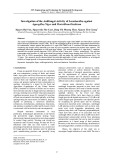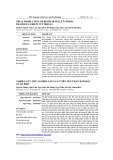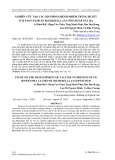
Nong Lam University, Ho Chi Minh City 63
The Journal of Agriculture and Development 23(Special issue 1) www.jad.hcmuaf.edu.vn
Assessment of the immunity gap of two vaccination programs against Gumboro disease in
Luong Phuong chickens
Lan T. H. Huynh, Truc L. T. Nguyen, Ho M. Nguyen, & Anh T. Quach*
Faculty of Animal Science and Veterinary Medicine, Nong Lam University, Ho Chi Minh City, Vietnam
ARTICLE INFO ABSTRACT
Research Paper
Received: August 30, 2024
Revised: September 24, 2024
Accepted: October 04, 2024
Keywords
Antibody titer
IBD
Immunity gap
M.B strain
228E strain
*Corresponding author
Quach Tuyet Anh
Email:
anh.quachtuyet@hcmuaf.edu.vn
Maternal-derived antibody (MDA) is the priority protection against
environmental Infectious Bursal Disease Virus (IBDV) in the first
weeks. The passive immunity decreases, but the active immunity is
not enough to protect chicks, so shortening the high-risk period is
crucial to IBD control. The objective of this study was to evaluate the
immunity gap between 2 vaccination programs against infectious
bursal disease (IBD) in Luong Phuong chickens. A total of 34,600
chicks were administered by subcutaneous injection of IBD vaccine
at 0.1 mL/dose at the hatchery. At 12 days old, 18,000 chicks were
vaccinated with the M.B strain vaccine and 16,600 chicks were
vaccinated with the 228E strain vaccine by drinking water. The
IBD and Newcastle disease (ND) antibody evaluations were based
on the Enzyme-linked immunosorbent assay (ELISA) technique.
Parameters were recorded until slaughter including body weight,
average daily gain, feed conversion rate, and mortality. The IBD
MDA at 1 day old was medium and uniform (3809 and 45.3%),
which could protect against IBD virus from 1 to 2 weeks old. At 28
days old, the IBD antibody titer of the MB vaccine was higher than
that of the 228E vaccine, various proportions of samples in the M.B
group exceeding 1,000 titers (40% vs. 0%), and it was a statistically
significant difference (1,133 vs. 161) (P < 0.01). Besides, the M.B
vaccine created a faster and stronger immune response than the
228E vaccine, shortening the immune gap and protecting chicks
earlier. The humoral immune response to the ND vaccine was
good, with no difference between 2 groups, which proved that
the M.B virus did not cause immunosuppression. The production
parameters of chickens between the 2 groups were the same. In
summary, the M.B vaccine made a short immune gap and did not
cause immunodeficiency in chickens.
Cited as: Huynh, L. T. H., Nguyen, T. L. T., Nguyen, H. M., & Quach, A. T. (2024). Assessment of the
immunity gap of two vaccination programs against Gumboro disease in Luong Phuong chickens.
The Journal of Agriculture and Development 23(Special issue 1), 63-73.

64 Nong Lam University, Ho Chi Minh City
The Journal of Agriculture and Development 23(Special issue 1) www.jad.hcmuaf.edu.vn
interference of MDA becomes a serious problem
at the proper time of vaccination against IBD
with a live vaccine (Berg, 2000). When the young
chickens are vaccinated with attenuated vaccines
too early that may lead to the neutralization of
vaccine by MDA, and otherwise, the chicken
flocks are poorly protected if applied too late due
to the low level of MDA and the active immunity
is not enough to prevent the field challenges (Dey
et al., 2019), so shortening the high-risk period is
crucial to IBD control.
Recently, the M.B strain vaccine has been
used quite commonly in chicken farms and walks
through the MDA levels of 800 Enzyme-linked
immunosorbent assay (ELISA) Idexx while
intermediate and intermediate plus vaccines
break through the levels of MDA titers are 125
and 500, respectively (De Wit, 2001). Besides,
the 228E strain vaccine is capable of walking
through the MDA levels of 500 ELISA Idexx
(De Wit, 2001). Intermediate and intermediate
plus vaccines create better protection than
mild vaccines, but they can cause severe bursal
lesions and induce corresponding levels of
immunosuppression (Rautenschlein et al., 2005).
Therefore, the level of live attenuated vaccine
influences the humoral immune response, and
especially the M.B strain breaks through a higher
MDA level. The objectives of this study were to
compare the immunity gap of 2 vaccination
programs and simultaneously to check whether
the M.B vaccine caused immunodeficiency like
other hot strain vaccines.
2. Materials and Methods
2.1. Experimental design
The study was carried out on a total of 34,600
Luong Phuong chickens, which were kept in
2 broiler houses of one commercial operation
farm with the same management procedures
from November 2023 to January 2024 in Binh
1. Introduce
The poultry industry is facing many serious
challenges, including Gumboro disease caused
by Infectious Bursal Disease Virus (IBDV)
which is the aetiological agent of an acute,
highly contagious, and immunosuppressive
disease particularly affecting chicks of 3 to 6
weeks of age. This infection transmits via the
fecal-oral route and two serotypes of IBDV
are identified: serotype 1 is pathogenic, while
serotype 2 is non-pathogenic. Serotype 1 is
classified into classical, intermediate, and very
virulent strains (Jayasundara et al., 2017).
Following oral infection, IBDV enters the
bloodstream, replicates in the macrophages
of the gut-associated tissues and lymphoid
cellsbefore it attains the bursa of fabricius (BF)
(Xu et al., 2024). In the fully susceptible chicken
flocks, the clinical disease includes dullness,
depression, ruffled feathers, anorexia, whitish
loose diarrhoea and severe dehydration (Islam &
Samad, 2004). The chickens less than 3 weeks of
age do not clearly exhibit clinical signs (Dahshan
& Hussien, 2011). Recovery from disease and
subclinical infection causes immunosuppression,
principally directs towards the B lymphocytes,
influences cell-mediated immunity, and leads
to vaccination failures (Ingrao et al., 2013).
Control of infectious bursal disease (IBD)
depends on poultry health management,
especially appropriate immunization schedules
and maintenance of good hygienic conditions
in farms (Farooq et al., 2003). However, IBDV
infection is mainly controlled by live attenuated
virus vaccines which are classified into a mild,
intermediate, intermediate plus, or hot based
on their residual virulence (Courtillon et al.,
2022). The parent stocks are administered with
an emulsion oil vaccine to boost an immune
response and Maternal-derived antibody (MDA)
in unvaccinated chickens persists up to 3 weeks
old and completely decays by 4 to 5 weeks of
age (Ahmed & Akhter, 2003). Moreover, the

Nong Lam University, Ho Chi Minh City 65
The Journal of Agriculture and Development 23(Special issue 1) www.jad.hcmuaf.edu.vn
by drinking water that was used in this farm for
a long time and was suitable for the epidemical
condition. Hence, house 1 was used as the
control group. Besides, house 2, 18,000 chicks,
were vaccinated with the M.B strain vaccine
containing at least 102.5 - 103 embryo infective
dose of 50% per dose by drinking water at the
same time. Other vaccines in the study were
applied according to the below immunization
schedule (Table 1).
Duong Province, Vietnam. All day-one chickens
(DOC) of the experiment were bought from the
same breeder company and therefore, they were
assumed to have the same MDA. All of them
were administered by subcutaneous injection
(SC) with an IBD immune complex vaccine
dose of 0.1 mL at the hatchery. At 12 days old,
house 1, 16,600 chicks, were vaccinated with the
live attenuated 228E strain vaccine containing at
least 102embryo infective dose of 50% per dose
Table 1. Immunization schedule of the current study
228E group (house 1) M.B group (house 2) Application
Age (days) Vaccine Age (days) Vaccine
1
(hatchery)
ND killed 1
(hatchery)
ND killed SC with a dose of 0.1 mL/chick
IBD IBD SC with a dose of 0.1 mL/chick
IB + ND IB + ND Spray
7 IB + ND 10 IB + ND Drop eye
12 228E strain 12 M.B strain Drinking water
14 AI 15 AI SC with a dose of 0.3 mL/chick
21 IB + ND 28 IB + ND Drinking water
35 IB + ND 35 ND Drinking water
2.2. Serology
Blood samples from 20 chicks were randomly
collected for the determination of the IBD and
ND MDA at 1 day old. After the second IBD
vaccination, at 21, 24, 28, and 34 days of age for
the determination of IBD antibodies and at 21,
28, and 42 days of age for the determination of
ND antibodies (Figure 1). Randomly selected 15
chicks per house were taken vein blood samples
at 21 days old and they were taken the leg mark
ring to follow the individual antibody chicks.
Then, these chicks were raised with the same
environmental conditions as others in the house
and continued to record their level of antibodies
at other times. All blood samples were let clot
naturally, were stored 2 - 8oC, and were sent to the
An Phu Tien laboratory in Dong Nai Province,
Vietnam. They were centrifuged at 3,000 rpm
for 5 minutes to extract serum. Two types of
commercial enzyme-linked immunosorbent
assay kits (Idexx, Maine, USA) were used as
described by the manufacturer to detect the
antibodies against IBD and ND in chicken serum.
As a result, the serum sample with an S/P ratio ≤
0.2 (titer ≤ 396) is negative and an S/P ratio > 0.2
(titer > 396) is positive.

66 Nong Lam University, Ho Chi Minh City
The Journal of Agriculture and Development 23(Special issue 1) www.jad.hcmuaf.edu.vn
2.4. Statistical analysis
The data were collected and analyzed by
Microsoft Excel 2016 and Minitab 16 software.
Using a one-way ANOVA model and the T-test
to compare the average level of antibodies
between 2 groups. The differences were
considered statistically significant with P < 0.05.
The coefficient variation CV (%) is interpreted as
< 30% excellent, 30 - 50% good, 51 - 80% fair,
and > 90% poor response to vaccine.
3. Results and Discussion
3.1. Maternally derived IBD antibodies
The MDA is key to protecting chicks against
virulent field IBDV strains during the first weeks
of age. According to Kreider et al. (1991), the
MDA is divided into 3 levels: low level (< 3,000),
medium level (3,000 - 5,000) and high level (>
6,000). Collecting randomly 20 serum samples
at 1 day old to determine their IBD MDA titers
based on the ELISA technique. The titers ranged
from 841 to 7,039 and the average titer was
medium and uniform (3,809 and 45.3%). The
Figure 1. The experimental design per house.
2.3. Performance
The survey was conducted to compare the
performance indicators of the broiler chicken
flocks when they were vaccinated with two
immunization schedules. The performance
parameters were followed until slaughter,
including body weight, average daily gain, feed
conversion ratio, and mortality. The total chicken
flock weight was only recorded at the time of
sale and the amount of feed was monitored
throughout the implementation period. The
productivity norms were calculated according to
the formula.
Average body weight (kg/chicken) = total
weight of chickens/total number of chickens
Average daily gain (g/day) = (total of final
weight - total of beginning weight)/total number
of survival chicken days)
Feed conversion rate = total amount of
consumed feed/total weight of chickens
Mortality (%) = total of dead chickens/total of
beginning chickens *100

Nong Lam University, Ho Chi Minh City 67
The Journal of Agriculture and Development 23(Special issue 1) www.jad.hcmuaf.edu.vn
to the Deventer formula to determine the age of
vaccination application (De Wit, 2001). The M.B.
strain was able to break through the MDA level
of 800 ELISA Idexx and therefore a suitable time
could be vaccinated at 13 days old. On the other
hand, the available vaccination procedure of the
farm was applied by the 228E vaccine at 12 days
old, which was considered a standard program,
and suitable for epidemical conditions. Hence,
the second vaccination against IBD used for 2
programs was at 12 days of age.
chicks of 2 houses were bought from the same
breeder company. The half-life time of MDA is 3.8
days for Luong Phuong chickens (De Wit, 2001),
so these titers can protect the young chickens
against field viruses from 1 to 2 weeks old. The
MDA can potentially neutralize the vaccine if
done on very younger progeny chickens (Ahmed
& Akhter, 2003). The interference of MDA is a
major problem for the best time to vaccinate,
serological monitoring is necessary to evaluate
the level of MDA and decide the appropriate
timing for vaccination (Berg, 2000). According
3.2. IBD antibodies post second vaccination
Table 2. Infectious bursal disease (IBD) antibody titers
Age M.B group 228E group P
Mean titer CV (%) N Mean titer CV (%) N
IBD 21 days old 186 55.7 15 168 83.4 14 0.696
IBD 24 (25) days old 146 41.9 14 117 80.4 14 0.328
IBD 28 days old 1,133a88.4 15 161b97.1 14 0.001
IBD 34 days old 2,215 41.1 15 1,991 56.6 15 0.554
a- bMean values of traits in rows, marked with different letters, differ statistically significantly between groups
(P < 0.01).
Figure 2. Infectious bursal disease (IBD) antibody titers of individual chickens.



![Đề cương môn Vi sinh vật thú y [chuẩn nhất]](https://cdn.tailieu.vn/images/document/thumbnail/2025/20250414/trantrongkim2025/135x160/1263896842.jpg)






















